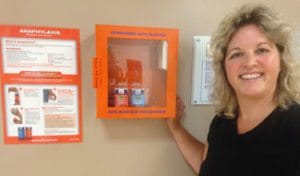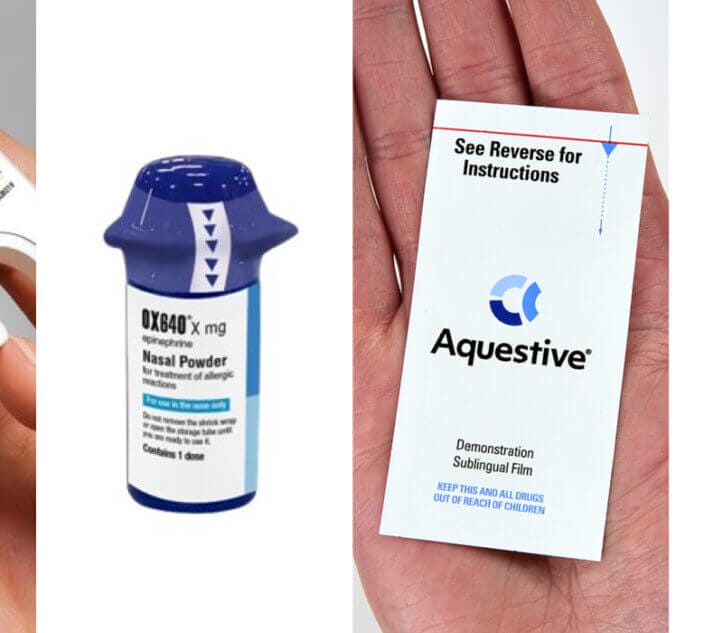 Kelly Dunfield stands next to one of the epinephrine auto-injector cabinets –containing both adult and child dosages –that she and her son rallied their community to install in 30 public locations in their hometown.
Kelly Dunfield stands next to one of the epinephrine auto-injector cabinets –containing both adult and child dosages –that she and her son rallied their community to install in 30 public locations in their hometown. Carrying an epinephrine auto-injector, especially when planning to eat food served at a public place, can be a life-saving proposition. But should forgetting yours that one time, or not being able to communicate where it is, or how to use it, or having a first reaction to an unknown allergy at the wrong place and time end up costing someone their life?
A Canadian nurse practitioner is determined to prevent that from being the case, and her program is already showing results by saving a man’s life.
Kelly Dunfield has spent more than a year working with partners to place epinephrine auto-injectors in 30 public locations in her town of Sussex, New Brunswick and surrounding region. This is the largest single community effort to date in Canada to make auto-injectors publicly available, and among the biggest such efforts in North America.
“Even as a health professional, if I’m somewhere out in public and someone is having an allergic reaction, if I don’t have an epinephrine auto-injector with me, the best I can do is call 911,” Dunfield says, noting that time is of the essence to get this life-saving medication in an anaphylactic emergency.
A case in point is an allergy emergency that occurred at a wilderness lodge near Sussex on Sept. 10. Wellington McLean, 53, was out riding an ATV with his family when he was stung in the face by wasps and went into anaphylaxis. By the time he was transported back to the lodge, he was having difficulty breathing and his lips were blue. Muriel McCallum, a first-aid responder, administered the stock epinephrine that was available at the lodge under the new program. While 911 was called, she notes that it was the two on-site auto-injectors (adult and children’s doses) that made all the difference for McLean.
“If the units hadn’t been there, I would have watched him die,” McCallum says. She used the adult device first and then, because McLean needed a second injection, she also administered the children’s dose. “That’s all I had, but it was enough until the ambulance arrived.”
Dunfield came up with the ambitious goal of making epinephrine auto-injectors publicly and quickly accessible when needed in her town, just like the AEDs (automated external defibrillators) that are widely available for heart-related emergencies. “I managed an emergency department years ago, and I never would have dreamt that there would be locally accessible AEDs now. So it’s really about a shift in thinking,” Dunfield told Allergic Living.
Armed with the experience of seeing attitudes toward medical emergencies evolve, Dunfield turned to practical concerns. She began working with her son Robert, a medical student, as well as a local allergist to develop a proposal for cabinets around the town that would provide proper storage for the life-saving devices. One of her first moves was to find out where the AED cabinets were produced.
“We wanted them to be distinguished from the AED cabinets, because a lot of our cabinets are placed beside them. Then we chose a bright color, because we wanted to make it easy for people to identify in an emergency,” she says. A community foundation agreed to finance the cabinets.
Meantime, Dunfield reached out to Sanofi Canada, which manufactures the Allerject brand of epinephrine auto-injector. The company offered to provide the first 18 months supply of Allerject auto-injectors (known as the Auvi-Q in the U.S.), as well as training materials. She says the individual venues have signed agreements to keep the cabinets up to date, and keep the auto-injectors replaced as they expire or are used. (In Canada, epinephrine auto-injectors don’t require a doctor’s prescription to purchase).
The New Brunswick region where the Dunfield lives has become quite aware of the risks of anaphylaxis following the death of Caroline Lorette, of Rothesay, N.B. The 14-year-old died in July 2014 from a severe reaction to a food containing dairy.
Dunfield worked with businesses and community institutions to choose the right spots to have auto-injectors on-hand for emergencies. Beyond schools, sports arenas, community centers, the lodge, a golf course and other public venues, “we also have five restaurants right now who have come on board now. We want it in restaurants because we know food allergies are prevalent,” she adds.
The project goes well beyond device placement; it’s also about educating the public, and specifically those who work daily with the public, about how and when to use the auto-injectors. “We’ve educated hundreds of people at this point,” says the medical professional. “One of our main goals was for people to not be fearful in emergency situations. We wanted people to be able to give it, and be comfortable giving it.”
Dunfield and her team taught people on both EpiPen and Allerject devices, since most with severe allergies will carry their own auto-injectors, and that could be either brand.
In the United States, efforts to make stock epinephrine publicly available are also gaining ground. Sixteen states have now passed what are called “entity laws” that permit public venues – from restaurants to sports arenas and theme parks – to maintain stock epinephrine auto-injectors. More states are also considering such laws.
Dunfield and her team are motivated to see the stock epinephrine approach spread far and wide. “One of the most common comments from people we’ve taught to use the auto-injectors has been: ‘We need more of this. This needs to be happening across the country. Or countries. We need this to be available.'”
To that end, her son “has just developed a ‘how-to’ manual and a PowerPoint presentation that we can offer communities to deliver a public auto-injector program in their towns and cities. That’s how we see our role now, to support the expansion of this beyond our own community.”
To find out more about getting the manual for your community, contact Kelly Dunfield at [email protected].





